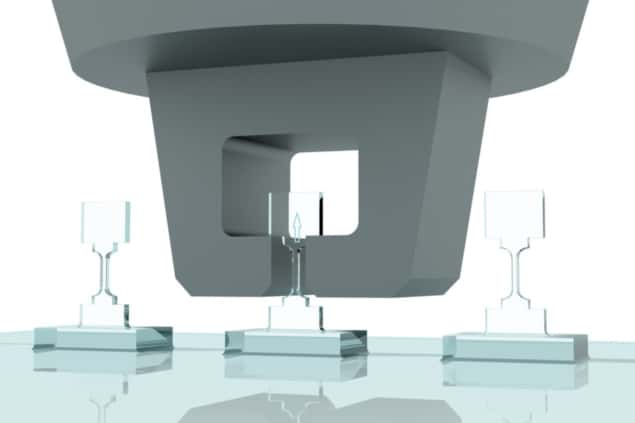
Normally brittle diamond has been stretched by almost 10% by an international team of scientists in China. Modelling done by the team suggests that this stretching significantly alters the electronic properties of the material, which could lead to new applications for diamond such as LEDs and variable-colour lasers.
As well as shining brilliantly in jewelry, diamond has long fascinated scientists for its range of extraordinary properties. Diamond is the hardest material on Earth, has very high charge-carrier mobility and is almost totally transparent. It also has a high thermal conductivity and a very high dielectric breakdown strength – a combination that would be useful in high-power electronic devices.
Unfortunately, diamond has several properties that make it unsuitable for electronic applications. It has a very large indirect band gap of 5.47 eV, giving it very few free charge carriers. Moreover, indirect band gap semiconductors do not interact efficiently with light via electronic transitions, so diamond cannot be used as a light source or a solar cell.
Strain engineering
The electronic properties of semiconductors can be altered by adding impurity atoms (doping), but this is very difficult in diamond because of the rigidity of its carbon lattice. An alternative to doping is strain engineering, which involves changing the atomic spacing in a lattice. The processor in every modern PC, for example, contains strained silicon with electron or hole mobility that has been altered by strain engineering.
“In silicon – which we’re also working on – if you apply just a 1% strain you see a huge change in electrical mobility,” explains joint team leader Yang Lu of the City University of Hong Kong. In the new research, the team looked at whether strain engineering could help with diamond.
Theoretical calculations suggest that the diamond lattice should withstand strains up to about 12%. In practice however, when real diamonds are stressed, the strain becomes concentrated at defects in the lattice, causing the diamonds to break rather than stretch.
High elasticity
In 2018, Lu and colleagues etched nanoscale diamonds and, by bending them, demonstrated that diamonds could show high elasticity: “We discovered this, but the straining method can’t be well characterized,” explains Lu. “Since then, a lot of other groups have done follow up work – mostly computational – predicting band gap change, metallization and even superconductivity.” Testing these predictions, however, requires the precise characterization of the strain.
In their new research, Lu and colleagues used advanced fabrication processes to produce micron-scale, T-shaped samples of single-crystal diamond, which they stretched using a custom-made mechanical gripper (see figure). They measured different Young’s moduli along different crystallographic axes, achieving a maximum strain of 9.7% before the diamond fractured. At lower values, the lattice returned to its original configuration when the strain was removed.
“We managed to microfabricate diamond into the shape and geometry that we want,” says Lu. “This is just an illustration of the device concept. We can scale up.”
Direct band gap
Experimental limitations prevented the researchers from directly measuring the effects of stretching on the electronic band structure of their samples. However, calculations done using density functional theory and their experimental data suggest that along one crystalline axis, the band gap falls from above 5 eV to around 3 eV at around 9% strain. Along another axis, the band gap changes from indirect to direct.
Lu’s group is now looking at several possible applications for stretched diamond including making lasers of different colours. “Intrinsically, diamond has a wide band gap so would produce UV light,” he says. “Now imagine if we stretch the diamond, it goes from ultraviolet to violet, and if we stretch it further it goes from violet to red.”

The diamond quantum revolution
Christoph Nebel, founding director of the German diamond and carbon technology consultancy Diacara, says that tuning the band structure of semiconductors using pressure and tensile stress “is a very old story going to the 1950s”. He adds, “What is surprising is that you can apply such a strong tensile stress without the diamond breaking.”
Mark Newton of the University of Warwick in the UK agrees that the crucial result is the elasticity: “They’ve opened up all of these possibilities by demonstrating this level of strain. The changes that this could have for all the electronic and optoelectronic properties are just a sentence at the end of their paper but that’s where the cool stuff will come.” He is particularly intrigued by the change to a direct band gap which he says, could potentially lead to a diamond-based LED.
The research is described in Science.
